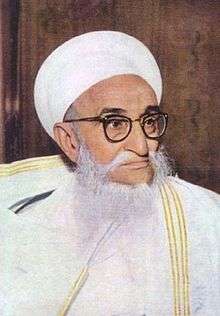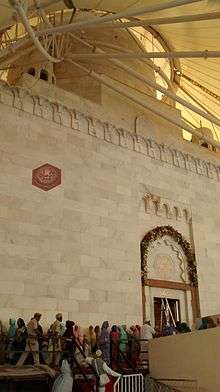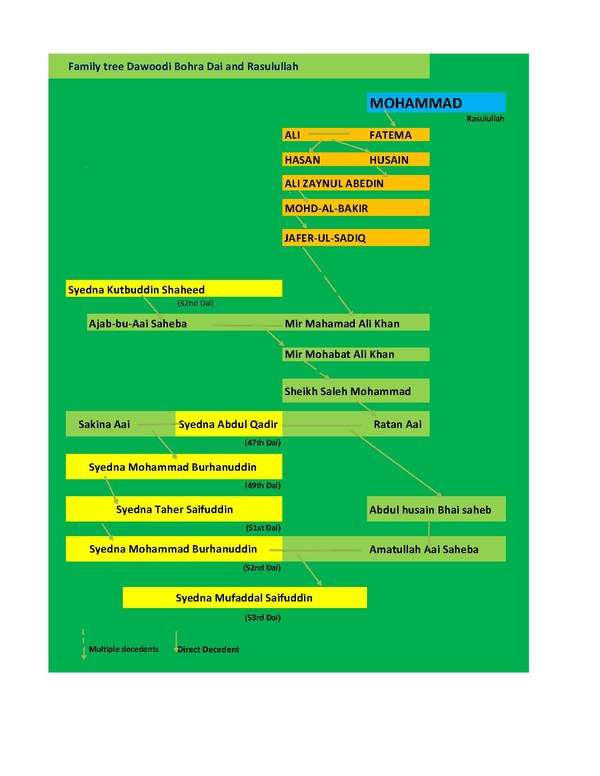Taher Saifuddin
| Syedna Taher Saifuddin 51st Da'i al-Mutlaq of the Dawoodi Bohra | |
|---|---|
 | |
| Born |
4 August 1888 Surat, British Raj |
| Died |
12 November 1965 (aged 77) Matheran, India |
| Resting place | Raudat Tahera, Mumbai |
| Organization | Chancellor, Aligarh (1953-65) |
| Style | His Holiness |
| Term | 1915–1965 |
| Predecessor | Abdullah Badruddin |
| Successor | Mohammed Burhanuddin, son |
| Spouse(s) | Aaisaheba Husaina |
| Parent(s) |
Mohammad Burhanuddin Aaisaheba Amatullah |
| Family tree Moulai Tarmal/Bharmal to Syedna Burhanuddin | ||||||||||||||||||||||||||||||||||||||||||||||||||||||||||||||||||||||||||||||||||||||||||||||||||||||||||||||||||||||||||||||||||||||||||||||||||||||||||||||||||||||||||||||||||||||||||||||||||||||||||||||||||||||||||||||||||||||||||||||||||||||||||||||||||||||||||||||||||||||||||||||||||||||||||||||||||||||||||||||||||||||||||||||||||||||||||||||||||||||||||||||||||||||||||||||||||||||||||||||||||||||||||||||||||||||||||||||||||||||||||||||||||||||||||||||||||||||||||||||||||||||||||||||||||||||||||||||||||||||||||||||||||||||||||||||||||||||||||||||||||||||||||||||||||||||||||||||||||||||||||||||||||||||||||||||||||||||||||||||||||||||||||||||||||||||||||||||||||||||||||||||||||||||||||||||||||||||||||||
|---|---|---|---|---|---|---|---|---|---|---|---|---|---|---|---|---|---|---|---|---|---|---|---|---|---|---|---|---|---|---|---|---|---|---|---|---|---|---|---|---|---|---|---|---|---|---|---|---|---|---|---|---|---|---|---|---|---|---|---|---|---|---|---|---|---|---|---|---|---|---|---|---|---|---|---|---|---|---|---|---|---|---|---|---|---|---|---|---|---|---|---|---|---|---|---|---|---|---|---|---|---|---|---|---|---|---|---|---|---|---|---|---|---|---|---|---|---|---|---|---|---|---|---|---|---|---|---|---|---|---|---|---|---|---|---|---|---|---|---|---|---|---|---|---|---|---|---|---|---|---|---|---|---|---|---|---|---|---|---|---|---|---|---|---|---|---|---|---|---|---|---|---|---|---|---|---|---|---|---|---|---|---|---|---|---|---|---|---|---|---|---|---|---|---|---|---|---|---|---|---|---|---|---|---|---|---|---|---|---|---|---|---|---|---|---|---|---|---|---|---|---|---|---|---|---|---|---|---|---|---|---|---|---|---|---|---|---|---|---|---|---|---|---|---|---|---|---|---|---|---|---|---|---|---|---|---|---|---|---|---|---|---|---|---|---|---|---|---|---|---|---|---|---|---|---|---|---|---|---|---|---|---|---|---|---|---|---|---|---|---|---|---|---|---|---|---|---|---|---|---|---|---|---|---|---|---|---|---|---|---|---|---|---|---|---|---|---|---|---|---|---|---|---|---|---|---|---|---|---|---|---|---|---|---|---|---|---|---|---|---|---|---|---|---|---|---|---|---|---|---|---|---|---|---|---|---|---|---|---|---|---|---|---|---|---|---|---|---|---|---|---|---|---|---|---|---|---|---|---|---|---|---|---|---|---|---|---|---|---|---|---|---|---|---|---|---|---|---|---|---|---|---|---|---|---|---|---|---|---|---|---|---|---|---|---|---|---|---|---|---|---|---|---|---|---|---|---|---|---|---|---|---|---|---|---|---|---|---|---|---|---|---|---|---|---|---|---|---|---|---|---|---|---|---|---|---|---|---|---|---|---|---|---|---|---|---|---|---|---|---|---|---|---|---|---|---|---|---|---|---|---|---|---|---|---|---|---|---|---|---|---|---|---|---|---|---|---|---|---|---|---|---|---|---|---|---|---|---|---|---|---|---|---|---|---|---|---|---|---|---|---|---|---|---|---|---|---|---|---|---|---|---|---|---|---|---|---|---|---|---|---|---|---|---|---|---|---|---|---|---|---|---|---|---|---|---|---|---|---|---|---|---|---|---|---|---|---|---|---|---|---|---|---|---|---|---|---|---|---|---|---|---|---|---|---|---|---|---|---|---|---|---|---|---|---|---|---|---|---|---|---|---|---|---|---|---|---|---|---|---|---|---|---|---|---|---|---|---|---|---|---|---|---|---|---|---|---|---|---|---|---|---|---|---|---|---|---|---|---|---|---|---|---|---|---|---|---|---|---|---|---|---|---|---|---|---|---|---|---|---|---|---|---|---|---|---|---|---|---|---|---|---|---|---|---|---|---|---|---|---|---|---|---|---|---|---|---|---|---|---|---|---|---|---|---|---|---|---|---|---|---|---|---|---|---|---|---|---|---|---|---|---|---|---|---|---|
|
| ||||||||||||||||||||||||||||||||||||||||||||||||||||||||||||||||||||||||||||||||||||||||||||||||||||||||||||||||||||||||||||||||||||||||||||||||||||||||||||||||||||||||||||||||||||||||||||||||||||||||||||||||||||||||||||||||||||||||||||||||||||||||||||||||||||||||||||||||||||||||||||||||||||||||||||||||||||||||||||||||||||||||||||||||||||||||||||||||||||||||||||||||||||||||||||||||||||||||||||||||||||||||||||||||||||||||||||||||||||||||||||||||||||||||||||||||||||||||||||||||||||||||||||||||||||||||||||||||||||||||||||||||||||||||||||||||||||||||||||||||||||||||||||||||||||||||||||||||||||||||||||||||||||||||||||||||||||||||||||||||||||||||||||||||||||||||||||||||||||||||||||||||||||||||||||||||||||||||||||
| Broken lines indicate multiple generations | ||||||||||||||||||||||||||||||||||||||||||||||||||||||||||||||||||||||||||||||||||||||||||||||||||||||||||||||||||||||||||||||||||||||||||||||||||||||||||||||||||||||||||||||||||||||||||||||||||||||||||||||||||||||||||||||||||||||||||||||||||||||||||||||||||||||||||||||||||||||||||||||||||||||||||||||||||||||||||||||||||||||||||||||||||||||||||||||||||||||||||||||||||||||||||||||||||||||||||||||||||||||||||||||||||||||||||||||||||||||||||||||||||||||||||||||||||||||||||||||||||||||||||||||||||||||||||||||||||||||||||||||||||||||||||||||||||||||||||||||||||||||||||||||||||||||||||||||||||||||||||||||||||||||||||||||||||||||||||||||||||||||||||||||||||||||||||||||||||||||||||||||||||||||||||||||||||||||||||||
Syedna Taher Saifuddin bin Syedna Mohammad Burhanuddin[1] (سيدنا طاهر سيف الدين, 4 August 1888 – 12 November 1965) was the 51st Da'i al-Mutlaq of the Dawoodi Bohras, a section within Shia Islam. He was the son of the 49th Da'i al-Mutlaq Mohammed Burhanuddin, whose family lineage can be traced back to Syedi Fakhruddin Shaheed.
During his reign, Taher Saifuddin RA adapted the modernisation in Western and European ideas, and over the course of it, he established its benefits for the Bohra community. This sets him an ideal for the mixture of modern isation, education while being rooted in the traditions and the culture of the Fatimi Heritage and his son and successor Syedna Mohammad Burhanuddin and grandson and his successor Syedna Aaliqadr Mufaddal Saifuddin have continued in his path taking giant strides in the benefit of the community. ,
Early life
Sayedna Taher Saifuddin was born to Mohammed Burhanuddin and Aaisaheba Amatullah Aaisaheba on 4 August 1888 in Surat, British Raj (now in the Indian state of Gujarat).
Da'i al-Mutlaq
Saifuddin became the 51st al-Dāʿī al-Mutlaq in the year 1915. He rebuilt or repaired many monuments of Fatimi Imams, al-Dāʿī al-Mutlaq and other prominent structures and artifacts.[2]
He was the Chancellor of the Aligarh Muslim University for four consecutive terms.[3][4] He was made honorary chancellor of this university, which had only few Bohra students.
Contributions to Islamic Institutions
Saifuddin contributed vast sums of money towards the refurbishment of mosques and shrines. He along with the Nizam of Hyderabad were among the few Indian Muslims to contribute towards the renovation of Al Aqsa Mosque in Jerusalem:[5] Sultan Tahir Saif al-Din is said to have come from India with one hundred and fifty of his followers...At the Jerusalem station he was welcomed by the Mufti and other Sheikhs of the Supreme Moslem Council and a number of Arab notables including Ragheb Bey Nashashibi. A troop of Arab boy scouts paraded in his honour and there were two bands from Moslem institutions...The sultan was reputed to be a man of great wealth who had made substantial contributions to the religious and political funds of the Arabs of this country.[6]
Syedna Taher Saifuddin also gifted the internal curtains which were kept in the Kaaba for decades to King Abdul Aziz of Saudi Arabia in 1354AH, with whom he kept warm relations.[7]
He constructed Ghurratul Masajid (Saifee Masjid)[8][9] in Mumbai, al Mahal al Saifee[9] for pilgrims in Mecca, the Zarih of Ali Ibn Abi Talib in Najaf and Husayn ibn Ali in Karbala and Cairo,[9] the mausoleum of Qutubuddin Shaheed and Fakhruddin Shaheed.[9] He also made and donated the Kiswah of the Kaaba.[9]
Family
Syedna Taher Saifuddin married Aaisaheba Husaina Aaisaheba, who was also from the family of Da'i al-Mutlaq. After her death, he then married Wazeerah Aaisaheba, Fatema Aaisaheba and Amenah Aaisaheba.
He had a total of 12 sons and 8 daughters. His sons were Syedna Mohammed Burhanuddin, Husain Husamuddin, Abdut Taiyeb Zakiyuddin, Yusuf Najmuddin, Ismail Shehabuddin, Hatim Hamiduddin, Qasim Hakimuddin, Aliasghar Kalimudddin, Shabbir Nooruddin, Abbas Fakhruddin, Khuzaima Qutbuddin and Mohammed al-Baqir Jamaluddin. His daughters were Asma Baisaheba, Maryam Baisaheba, Khadijah Baisaheba, Zahra Baisaheba, Shireen Baisaheba, Banu Baisaheba, Fatema Baisaheba and Zainab Baisaheba.[10]
His Holiness Syedna Taher Saifuddin belongs to family of Moulai Fakhruddin and Moulai Hakimuddin. He also has link with Mohammad Rasulullah family as indicated in tree placed below.
Literary works
Rasāʾil Ramaḍāniyya (Epistles)
The following are a list of Rasāʾil Ramaḍāniyya composed by Taher Saifuddin . Each Risalah (epistle) is given a title gematrically equivalent to the Hijri year of its publication:[11][12]
| ID | Title | Title (English) | Hijri | Pub. | Year |
|---|---|---|---|---|---|
| STS 01 | ضوء نور الحق المبين | Ḍawʾ nūr al-ḥaqq al-mubīn | 1335 | ||
| STS 02 | ثمرات علوم الهدى | Ṯamarāt ʿulūm al-hudā | 1337 | ||
| STS 03 | زهر رياض الازلية | Zahr al-riyāḍ al-azaliyya | 1338 | ||
| STS 04 | درر البشارت | Durar al-bišārāt | 1339 | ||
| STS 05 | المشرب الكوثري | Al-Mašrab al-kawṯarī | 1340 | ||
| STS 06 | درر الهدى المضيئة | Durar al-hudā al-muḍīʾa | 1341 | ||
| STS 07 | روض عالم القدس | Rawḍ ʿālam al-quds | 1342 | ||
| STS 08 | غرفة جنة | Ġurfat ǧanna | 1343 | ||
| STS 09 | غرة الحق | Ġurrat al-ḥaqq | 1344 | ||
| STS 10 | ثمار جنات عدن طيبة | Ṯimār ǧannāt ʿadnin ṭayyiba | 1345 | ||
| STS 11 | قطف شجرة خلدية | Qaṭf šaǧara ḫuldiyya | 1346 | ||
| STS 12 | زبدة برهان الصدق الواضح | Zubdat burhān al-ṣidq al-wāḍiḥ | 1347 | ||
| STS 13 | صبغ نور | Ṣibġ nūr | 1348 | ||
| STS 14 | غرس الجنة | Ġars al-ǧanna | 1349 | ||
| STS 15 | درر اسرار اْل الكرار | Durar asrār āl al-Karrār | 1350 | ||
| STS 16 | نور روض الجنة | Nūr rawḍ al-ǧanna | 1351 | ||
| STS 17 | بحر فضل كبير | Baḥr faḍl kabīr | 1352 | ||
| STS 18 | مسرات الفتح المبين | Masarrat al-fatḥ al-mubīn | 1353 | ||
| STS 19 | الباب حظيرة القدس | Al-Bāb ḥaẓīrat al-quds | 1354 | ||
| STS 20 | كرامة العقول الوضية | Karāmat al-ʿuqūl al-waḍiyya | 1355 | ||
| STS 21 | صفحات عرفات المعارف | Ṣafḥat ʿarafāt al-maʿārif | 1356 | ||
| STS 22 | انهار رياض الجنة | Anhār riyāḍ al-ǧanna | 1357 | ||
| STS 23 | سحب بركات الخلد | Suḥub barakāt al-ḫuld | 1358 | ||
| STS 24 | ذات البركة | Ḏāt al-baraka | 1359 | ||
| STS 25 | كوثر الخلد | Kawṯar ḫuld | 1360 | ||
| STS 26 | روضة فردوس | Rawḍat firdaws | 1361 | ||
| STS 27 | دلو غدير حق | Dalw Ġadīr ḥaqq | 1362 | ||
| STS 28 | مشربة تسنيم نور | Mašrabat tasnīm nūr | 1363 | ||
| STS 29 | سلسبيل حكم غدق | Salsabīl ḥikam ġadaq | 1364 | ||
| STS 30 | سرر رشد مرفوعة | Surar rušd Marfūʿa | 1365 | ||
| STS 31 | صور حوض مورود | Ṣuwar ḥawḍ mawrūd | 1366 | ||
| STS 32 | تكبير سكينة فتح مبين | Takbīr sakīnat fatḥ mubīn | 1367 | ||
| STS 33 | فلسفة فوز عظيم | Falsafat fawz ʿaẓīm | 1368 | ||
| STS 34 | تذكرة لبيب | Taḏkirat labīb | 1369 | ||
| STS 35 | سلسلة نعمة عظمى | 1370 | |||
| STS 36 | نعم الصبغة الالهية | 1371 | |||
| STS 37 | خزائن امام المتقين | 1372 | |||
| STS 38 | مفاتيح ياقوتة الحمراء | 1373 | |||
| STS 39 | نهر النور الشعشعاني | 1374 | |||
| STS 40 | بلاغ الدعاة الفاطميين | 1375 | |||
| STS 41 | اشعة الفيض الازلي | 1376 | |||
| STS 42 | امثال سدرة المنتهى | Amṯāl sidrat al-muntahā | 1377 | 1958 | |
| STS 43 | روضة دار السلام | Rawḍat dār al-Salām | 1378 | 1430 | 2009 |
| STS 44 | توحيد الملة البيضاء | Tawḥīd al-Millah al-Bayḍāʾ | 1379 | 1431 | 2010 |
| STS 45 | بركات اصحاب التطهير | Barakāt Aṣḥāb al-Taṭhīr | 1380 | 1432 | 2011 |
| STS 46 | كمال النعم السابغة | Kamāl al-Aiʿam al-Sābiġa | 1381 | 1433 | 2012 |
| STS 47 | تسبيح ذهب القدس | Tasbīḥ ḏahab al-Quds | 1382 | 1434 | 2013 |
| STS 48 | شموس بركات الربانيين[13] | Shumūs Barakāt al-Rabbāniyīn | 1383 | 1435 | 2015 |
| STS 49 | انهار فيوض الفاطميين[14] | Anhār Fūyūz al-Fātimiyyīn | 1384 | 1436 | 2016 |
The Chandabhoy Galla Case

The Chandabhoy Galla Case is celebrated case in the history of religion where a human being is challenged for the representative of God on earth who is infallible and immaculate. The case was filed by the Advocate General of Mumbai at the behest of Adamjee Pirbhai family members against Syedna Taher Saifuddin. The case was filed in 1917 and decided in 1921. The claim was based on the belief of Imam as representative of the Prophet, and through him the representative of God, having withdrawn from the world, someone must represent him, and so ultimately the Deity on earth. The Dai, according to community religious belief, is that representative. The ownership of the Chandabhoy ‘Galla’( box kept for religious offerings) was denied on the plea of improper succession. [15] [16]
Concluding this extraordinary case then Advocate general Strangman remark about Syedna Taher saifuddin recorded is as follows [17] :
"Looking back on the proceedings, I think what impressed me the most, even more than the extravagance of the claims, was the personality of the Mullaji, a frail looking figure possessed nevertheless of an iron will, great determination, and organising capacity. At the time he assumed office the administration must have been extremely slack. Yet he managed in a very few years not only to pull the administration together but to obtain a hold upon his followers greater perhaps than that of any of his predecessors."
During testimony of 51st Dai Syedna Taher Saifuddin, he clarified about knowledge classes of 'Zahir', 'Tavil' and, 'Hakikat' present in community. First two are known to many but third one namely 'Hakikat' content some religious truths known to very few. Some of which are known to only 2 or 3 persons in community, and there is also knowledge which is available with Dai only, and he gets it from his predecessor Dai.[18]
Death
Saifuddin died on 12 November 1965 in Matheran, Maharashtra, India.[19] His mausoleum is known as Raudat Tahera located in Mumbai, and was constructed by his successor, Mohammed Burhanuddin.
See also
References
- ↑ Hozefa Mohiyuddin, Tufatuh ale Akhbaare Hudat, Al Jamea tus Saifiyah Publication, 1995, pg. 109
- ↑ "Sheikh al Doat al Mutlaqeen: Syedna Taher Saifuddin (R.A) - Anjuman-e-Najmi". Sfjamaat.org. Retrieved 2014-03-12.
- ↑ (Dr. Rahat Abrar (PRO), Chancellors of AMU, www.amu.ac.in, 22 February reverted)
- ↑ "51st Dai at Aligarh". thedawoodibohras.com. Retrieved 2016-07-27.
- ↑ http://twocircles.net/2010apr28/indian_muslims_and_palestine_waqfs.html#.VPDXP0J3bBI
- ↑ http://www.business-standard.com/article/beyond-business/indian-oasis-114082201282_1.html
- ↑ http://www.arabnews.com/news/494566
- ↑ "Saifee Masjid - Wikimapia". wikimapia.org. Retrieved 2016-07-27.
- 1 2 3 4 5 "The Dawoodi Bohras - al-da`i al-Mutlaq". thedawoodibohras.com. Retrieved 2016-07-27.
- ↑ Indorewala, Haider; Indorewala, Saifuddin; Indorewala, Shabbir (1975). سيدنا طاهر سيف الدين ني حيوة طيبة ني ايك جهلك. Anjuman e Taiyebi - Indore. p. 49.
- ↑ ميزة مفتاح خزائن العلوم. Mumbai, India.: Aljamea-tus-Saifiyah, Badri Mahal.
- ↑ Traboulsi, Samer (2016). "Transmission of Knowledge and Book Preservation in the Ṭayyibī Ismāʿīlī Tradition". Intellectual History of the Islamicate World – via Brill.
- ↑ His Holiness, Syedna Aali Qadr Mufaddal Saifuddin Saheb (2015). شموس بركات الربانيين. His Holiness Syedna Aali Qadr Mufaddal Saifuddin Saheb, Badri Mahal, Mumbai, India, 1435H.
- ↑ His Holiness, Syedna Aali Qadr Mufaddal Saifuddin Saheb (1436H). انهار فيوض الفاطميين. His Holiness Syedna Aali Qadr Mufaddal Saifuddin Saheb, Badri Mahal, Mumbai, India.
- ↑ ; Mullahs on the Mainframe: Islam and Modernity Among the Daudi Bohras; By Jonah Blank; p-236,2001.
- ↑ ; History A Modern History of the Ismailis: Continuity and Change in a Muslim Community; edited by Farhad Daftary 2010 - Social Science; egal battle with dissidents:-'chandbhai case, internal dissent: legitimacy of nass on abdul qadi nazmuddin –nazim dai 50 yearts'.
- ↑ ; MULLAJI CASE (CHANDABHOY GULLA CASE)-19l8-19l9
- ↑ ;Record No. 52; Syedna Taher Saifuddin’s RA Testimony in the Chandabhoy Galla Case 1920, pp. 280-284
- ↑ (Webzone, H. H. Dr Syedna Taher Saifuddin Memorial Foundation, www.matheranmemorialhall.com, 22 February reverted) Archived 27 December 2013 at the Wayback Machine.
Further reading
- Abdul Qaiyum Mulla Habibullah, His Holiness Syedna Taher Saifuddin Saheb, Dai-ul-Mutlaq of Dawoodi Bohra, Dawoodi Bohra Book Depot Publications,1953.
- Syedna Taher Saifuddin: A Philosophical Discourse, Al Jamea tus Saifiyah Publications 1963.
- Life and Works of His Holiness Syedna Dr. Taher Saifuddin Saheb, Leader Press Pvt. Ltd. Publications.
- Jafar us Sadiq Mufaddal Saifuddin, Al Aqmar: A Living Testimony to the Fatemiyeen, Al Jamea tus Saifiyah Publications, 2000.
- Jafar us Sadiq Mufaddal Saifuddin, Al Juyushi: A Vision of the Fatemiyeen, Al Jamea tus Saifiyah Publications, 2002.
- Mustafa Abdulhussein, Al-Dai Al-Fatimi Syedna Mohammed Burhanuddin: An Illustrated Biography, Al Jamea tus Saifiyah Publications.
- (A Chronological List of Duatil Mutlaqin)

| Da'i al-Mutlaq of Dawoodi Bohra sect | ||
|---|---|---|
| Preceded by Abdullah Badruddin |
51st Da'i al-Mutlaq 1915-1965 |
Succeeded by Mohammed Burhanuddin |